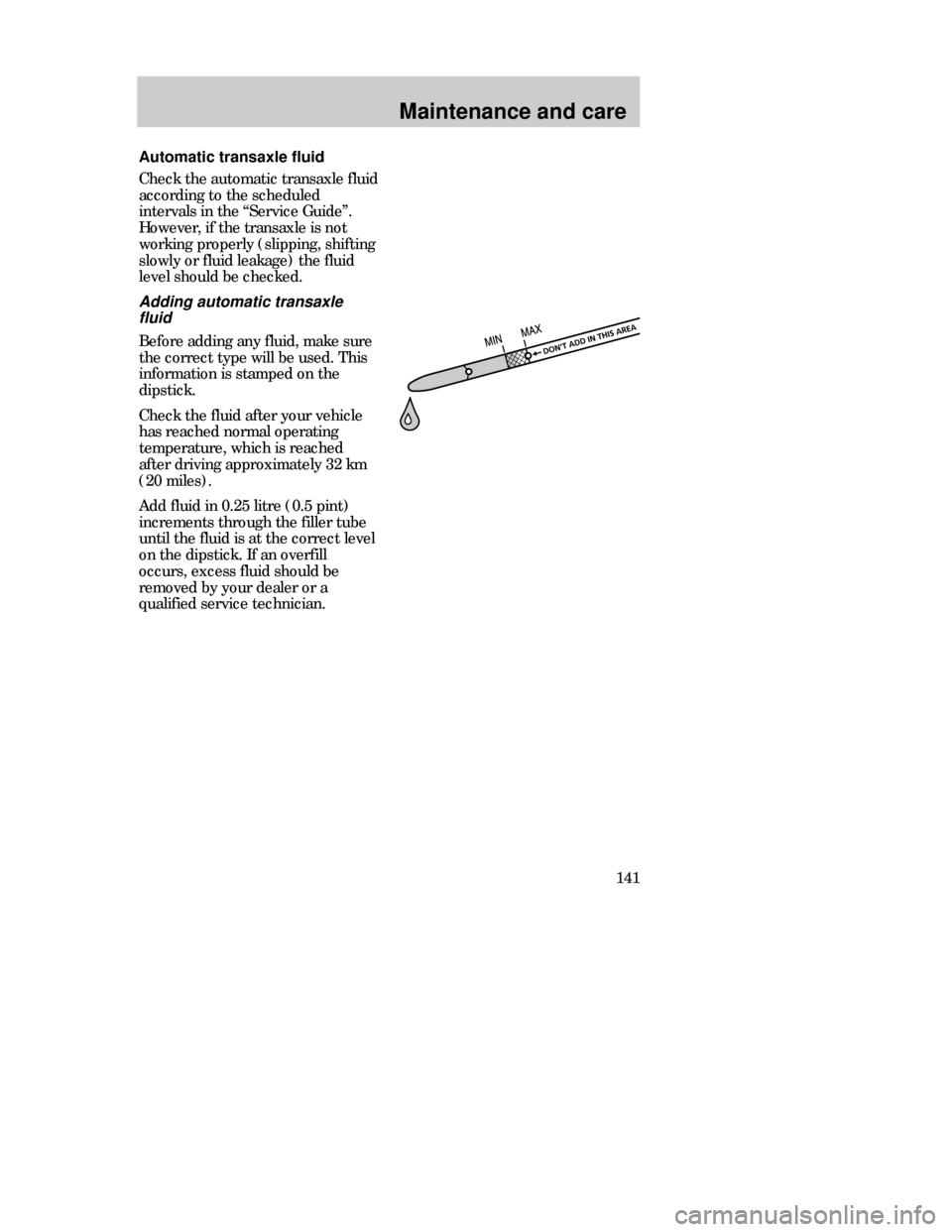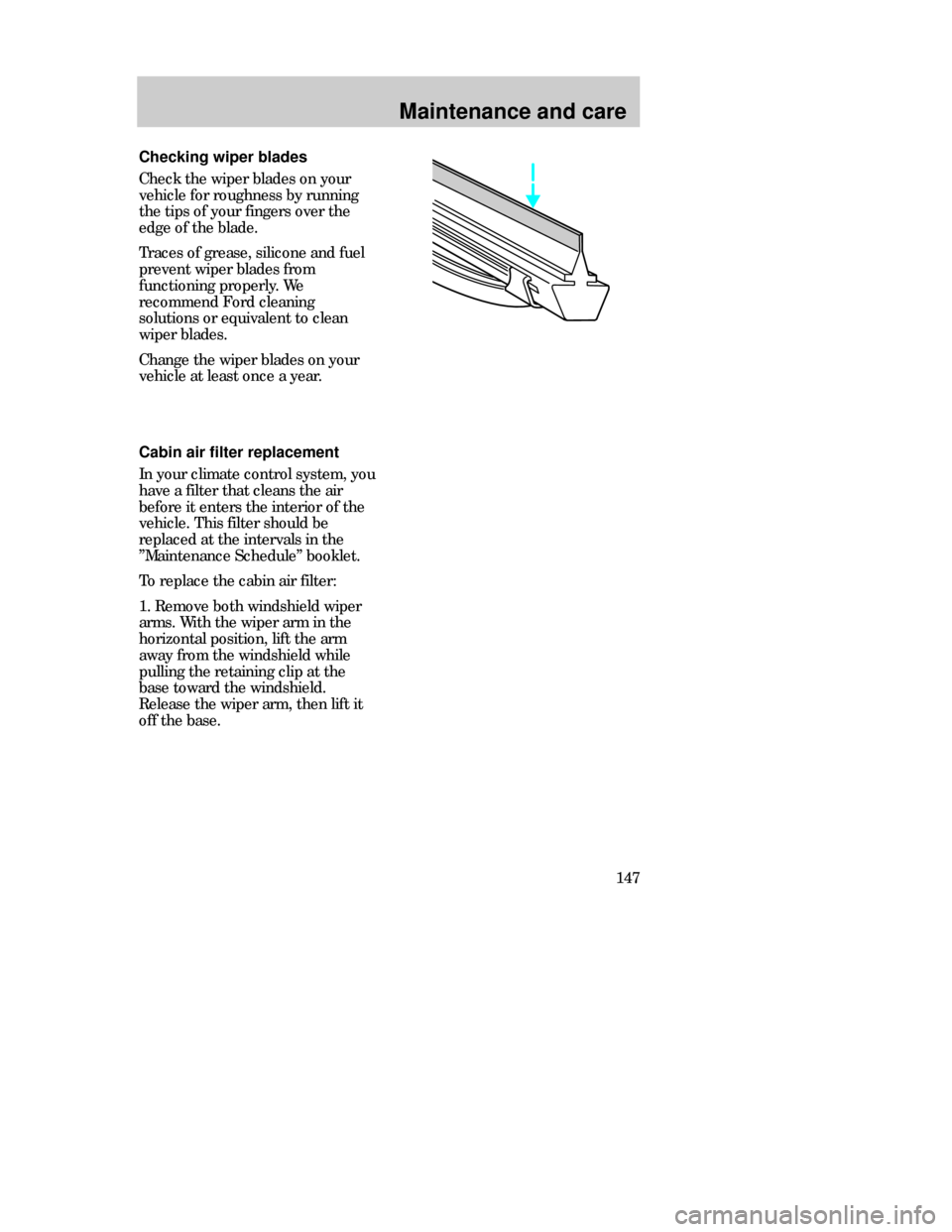Mercury Mystique 1998 Owner's Manuals
Manufacturer: MERCURY, Model Year: 1998, Model line: Mystique, Model: Mercury Mystique 1998Pages: 196, PDF Size: 1.65 MB
Page 141 of 196

Maintenance and care
141 Automatic transaxle fluid
Check the automatic transaxle fluid
according to the scheduled
intervals in the “Service Guide”.
However, if the transaxle is not
working properly (slipping, shifting
slowly or fluid leakage) the fluid
level should be checked.
Adding automatic transaxle
fluid
Before adding any fluid, make sure
the correct type will be used. This
information is stamped on the
dipstick.
Check the fluid after your vehicle
has reached normal operating
temperature, which is reached
after driving approximately 32 km
(20 miles).
Add fluid in 0.25 litre (0.5 pint)
increments through the filler tube
until the fluid is at the correct level
on the dipstick. If an overfill
occurs, excess fluid should be
removed by your dealer or a
qualified service technician.
CDW VA1-19Maint en MM 5/15/97 7:56 PM Page 141
Page 142 of 196

Maintenance and care
142
Checking the automatic
transaxle fluid
With the vehicle on a level surface
and the brake fully applied, start
the engine and move the gearshift
lever through all of the gears.
Securely latch the lever in P
(Park). Set parking brake and leave
the engine running.
Wipe off the dipstick cap and pull
the dipstick out. Wipe indicator
clean. Put dipstick back into filler
tube and make sure it is fully
seated. Pull the dipstick out and
read the fluid level.
Note that your vehicle should not
be driven until some fluid has been
added if the fluid level is below the
bottom dimple on the dipstick and
the outside temperature is above
10°C (50°F). Add only enough fluid
to bring the level above the bottom
hole.
If the vehicle has not been driven
and the fluid level is above the
bottom dimple on the dipstick,
don’t add fluid. Recheck the level
after driving your vehicle
approximately 30 km (20 miles)
when the engine has reached
normal operating temperature. The
fluid level should be within the
crosshatched area on the dipstick.
CDW VA1-19Maint en MM 5/15/97 7:56 PM Page 142
Page 143 of 196

Maintenance and care
143
MotorcraftSUPERSTART
Pb
Battery
Your vehicle may be equipped with
a Motorcraft maintenance-free
battery. The Motorcraft
maintenance-free battery normally
does not require additional water
during its life of service. However,
for severe service usage or in high
temperature climates, check your
battery electrolyte level, at least
every 24 months or 40 000 km
(24 000 miles). Keep the
electrolyte in each cell up to the
“level” indicator. Do not overfill the
battery cell.
For longer, trouble-free operation,
keep the top of the battery clean
and dry. Also, make certain the
battery cables are always tightly
fastened to the battery terminals.
If you see any corrosion on the
battery cables or terminals, remove
the cables from the terminal(s) and
clean with a wire brush. You can
neutralize the acid with a solution
of baking soda and water. Reinstall
the cables when you are done
cleaning them, and apply a small
quantity of grease to the top of
each battery terminal to help
prevent corrosion.
CDW VA1-19Maint en MM 5/15/97 7:56 PM Page 143
Page 144 of 196

Maintenance and care
144Battery replacement
If your original equipment battery
requires replacement while under
warranty, it will be replaced with a
Motorcraft service battery,
identical in design technology. Like
the original equipment battery, it
should not require water addition
during its normal life of service;
however, for severe service usage
or in high temperature climates,
check your battery electrolyte
level, at least every 24 months or
40 000 km (24 000 miles). Do not
overfill the battery cell.
If the electrolyte level in your
battery gets low, you can add plain
tap water to the battery, as long as
you do not use hard water (water
with a high mineral or alkali
content). If possible, however, try
to only fill the battery cell with
distilled water. If the battery needs
water often, have the charging
system checked.
CDW VA1-19Maint en MM 5/15/97 7:56 PM Page 144
Page 145 of 196

Maintenance and care
145
Batteries normally produce
explosive gases which can
cause personal injury. Do not allow
flames, sparks or lit tobacco to
come near the battery. Always
cover your face and protect your
eyes and also provide ventilation.
Applying too much pressure
on the ends when lifting a
battery could cause acid to spill.
Lift the battery with a carrier or
with your hands on the opposite
corners.
Follow these steps to
minimize risk of personal
injury.
Always dispose of automotive
batteries in a responsible
manner. Follow your community’s
local standards for disposal. Call
your local recycling center to find
out more about recycling
automotive batteries.
CDW VA1-19Maint en MM 5/15/97 7:56 PM Page 145
Page 146 of 196

Maintenance and care
146Relearning the idle function
Because your vehicle’s engine is
electronically controlled, some
control conditions are maintained
by power from the battery. When
the battery is disconnected or a
new battery is installed, the
computer must “relearn” its idle
conditions before your vehicle can
drive properly. To begin this
process:
1. Put the automatic transaxle
gearshift in P (Park). Put the
manual transaxle gearshift in
neutral.
2. Turn off all accessories and start
the vehicle.
3. Let the engine idle for at least
one minute.
4. The “relearning” process will
automatically complete as you
drive the vehicle.
•If you do not allow the engine to
“relearn” its idle, the idle quality
of your vehicle may be adversely
affected until the idle is
eventually “relearned”.
•If the battery has been
disconnected or if a new battery
has been installed, the clock and
preset radio stations must be
reset once the battery is
reconnected.
CDW VA1-19Maint en MM 5/15/97 7:56 PM Page 146
Page 147 of 196

Maintenance and care
147 Checking wiper blades
Check the wiper blades on your
vehicle for roughness by running
the tips of your fingers over the
edge of the blade.
Traces of grease, silicone and fuel
prevent wiper blades from
functioning properly. We
recommend Ford cleaning
solutions or equivalent to clean
wiper blades.
Change the wiper blades on your
vehicle at least once a year.
Cabin air filter replacement
In your climate control system, you
have a filter that cleans the air
before it enters the interior of the
vehicle. This filter should be
replaced at the intervals in the
”Maintenance Schedule” booklet.
To replace the cabin air filter:
1. Remove both windshield wiper
arms. With the wiper arm in the
horizontal position, lift the arm
away from the windshield while
pulling the retaining clip at the
base toward the windshield.
Release the wiper arm, then lift it
off the base.
CDW VA1-19Maint en MM 5/15/97 7:56 PM Page 147
Page 148 of 196

Maintenance and care
1482. Remove the plastic caps from
the screws on the grille. Remove
the screws.
3. Open the hood. Pull off the
rubber weatherstrip at the back of
the engine compartment. Remove
the screws that hold the grille,
separate the two halves and
remove the grille.
4. The filter is in a housing at the
back of the engine compartment,
on the left side. Pull off the two
clips on the sides of the housing.
Slide out the housing and filter.
5. Slide the filter out of the
housing, replace with the new filter
and slide the housing and cabin air
filter back into place. Reinstall the
clips on the housing.
6. Replace the grille and wiper
arms.
CDW VA1-19Maint en MM 5/15/97 7:56 PM Page 148
Page 149 of 196

Maintenance and care
149 Information about tire quality
grades
New vehicles are fitted with tires
that have their Tire Quality Grade
(described below) molded into the
tire’s sidewall. These Tire Quality
Grades are determined by
standards that the United States
Department of Transportation has
set.
Tire Quality Grades apply to new
pneumatic tires for use on
passenger cars. They do not apply
to deep tread, winter-type snow
tires, space-saver or temporary use
spare tires, tires with nominal rim
diameters of 25 to 30 cm (10 to 12
inches) or limited production tires
as defined in Title 49 Code of
Federal Regulation Part
575.104(c)(2).
U.S. Department of
Transportation – Tire quality
grades:
The U.S. Department of
Transportation requires Ford to
give you the following information
about tire grades exactly as the
government has written it. IMPORTANT TIRE
MAINTENANCE INFORMATION
CDW VA1-19Maint en MM 5/15/97 7:56 PM Page 149
Page 150 of 196

Maintenance and care
150Treadwear
The treadwear grade is a
comparative rating based on the
wear rate of the tire when tested
under controlled conditions on a
specified government test course.
For example, a tire grade of 150
would wear one and one-half
(11/2) times as well on the
government course as a tire grade
100. The relative performance of
tires depends upon the actual
conditions of their use, however,
and may depart significantly from
the norm due to variations in
driving habits, service practices,
and differences in road
characteristics and climate.
Traction ABC
The traction grades, from highest
to lowest are A, B, and C, and they
represent the tire’s ability to stop
on wet pavement as measured
under test surfaces of asphalt and
concrete. A tire marked C may
have poor traction performance.
Warning: The traction grade
assigned to this tire is based on
braking (straightahead) traction
tests and does not include
cornering (turning) traction.
CDW VA1-19Maint en MM 5/15/97 7:56 PM Page 150